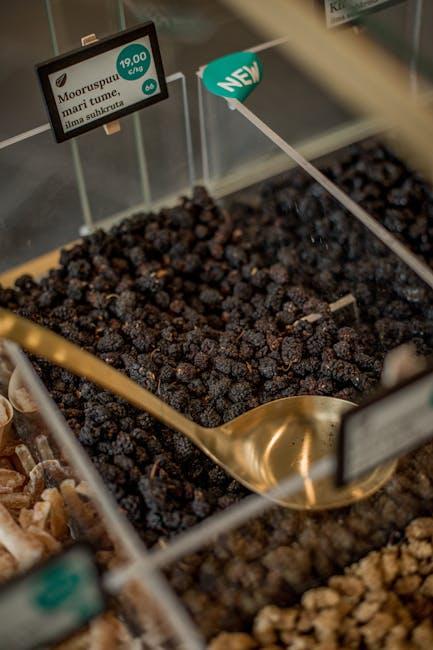Introducing new foods on the GAPS diet can feel like navigating uncharted waters—exciting yet uncertain. As you embark on this healing journey, each new ingredient offers a chance to restore balance and nurture your gut, but it also requires patience and mindful attention. Understanding how to thoughtfully incorporate new foods ensures that your digestive system is supported rather than overwhelmed, setting the stage for lasting wellness. In this article, we will explore practical strategies and gentle approaches to help you confidently expand your GAPS diet repertoire, turning every bite into a step toward vibrant health.
Table of Contents
- Understanding the GAPS Diet and Its Food Philosophy
- Preparing the Gut for New Foods
- Step-by-Step Strategies for Gradual Food Introduction
- Recognizing and Managing Potential Reactions
- Tailoring Food Choices to Individual Tolerances and Preferences
- Q&A
- Concluding Remarks

Understanding the GAPS Diet and Its Food Philosophy
The GAPS Diet embraces a food philosophy centered around healing the gut through nourishing, easy-to-digest meals. Unlike conventional diets that emphasize calorie counting or macronutrient ratios, this approach highlights the importance of whole, fermented, and nutrient-dense foods. The focus is on restoring gut flora balance, reducing inflammation, and gradually reintroducing foods to monitor the body’s response. This slow and mindful process ensures that the digestive system is not overwhelmed, allowing the body to rebuild its natural resilience.
Introducing new foods on this journey follows a very intentional path. Foods are reintroduced in stages, starting with gentle, soothing choices such as homemade bone broths and fermented vegetables that boost probiotics. It’s essential to watch for any reactions and keep a detailed food diary. Here’s a quick guide to ease into food variety:
- Start with simple broths and non-starchy vegetables to prepare the gut lining.
- Add fermented dairy or coconut yogurt if tolerated, as they provide beneficial bacteria.
- Introduce soft-cooked eggs and fish slowly to assess digestion.
- Incorporate fresh fruits last, beginning with small portions of low-sugar options.

Preparing the Gut for New Foods
Before welcoming new foods into your diet, it’s essential to nurture your digestive system’s resilience. Start with small, incremental additions, ensuring that each introduction is gentle enough to avoid overwhelming the gut. A calm digestive tract is better equipped to assimilate nutrients and cope with novel substances. Hydration with warm bone broths or herbal teas can soothe inflammation and promote a balanced microbiome, creating an ideal foundation for dietary expansion.
Keep in mind these key practices to assist your gut’s transition:
- Gradual exposure: Incorporate new foods one at a time over several days.
- Monitor reactions: Keep a food journal to track tolerance and any digestive changes.
- Support digestion: Use natural digestive aids like ginger or apple cider vinegar in small amounts.
- Consistency: Maintain a stable routine to help the gut adapt steadily rather than abruptly.
| Gut Prep Tip | Benefit |
|---|---|
| Bone Broth Fasts | Reduces inflammation and heals lining |
| Probiotic-rich foods | Enhances beneficial bacteria diversity |
| Mindful eating habits | Improves digestive efficiency |

Step-by-Step Strategies for Gradual Food Introduction
Embarking on the journey of introducing new foods on the GAPS diet requires patience and precision to ensure your gut healing process remains on track. Start by incorporating small quantities of one new food at a time, allowing your digestive system to adjust without overwhelming it. Observe how your body reacts within 24-48 hours before introducing another item. This cautious approach not only helps identify sensitivities but also builds your confidence in expanding your diet gradually. Opt for gentle, easy-to-digest foods first, such as homemade bone broths or fermented vegetables, rich in probiotics and nutrients that support gut restoration.
To keep the process organized and manageable, consider this strategy:
- List potential new foods you want to try, focusing on those highest in nutritional value and gut-healing properties.
- Keep a food journal to track symptoms, portion sizes, and preparation methods.
- Maintain a baseline diet of allowed GAPS foods to mix with new introductions for easier digestion.
- Adjust portion sizes based on tolerance, starting from a teaspoon and increasing gradually as tolerated.
| Food Group | First Choices | Notes |
|---|---|---|
| Fermented | Fermented cabbage, kefir | Start with small amounts to avoid bloating |
| Broths | Chicken bone broth, beef broth | Rich in collagen and gut-healing nutrients |
| Vegetables | Carrots, zucchini (cooked) | Steamed or boiled for easier digestion |

Recognizing and Managing Potential Reactions
When venturing into the introduction of new foods on the GAPS diet, it’s essential to stay vigilant for any signs your body might not be ready to assimilate them. Common reactions can vary widely—from subtle digestive upset like bloating or gas to more overt symptoms such as rashes, mood swings, or headaches. Keeping a food diary can be a game-changer; it not only helps you track what you have eaten but also pinpoints any adverse reactions correlated with specific foods. Monitoring these signals closely ensures you don’t move too quickly and provides critical insight into your unique tolerance levels.
Should symptoms arise, pause the introduction of the suspected item and consider implementing a gentle detox or a return to safer, well-tolerated foods to rebalance your system. Below is a simple table outlining typical reactions and suggested immediate responses that every GAPS follower might find useful:
| Reaction | Suggested Action |
|---|---|
| Digestive discomfort | Pause new foods, focus on bone broths |
| Skin rash | Eliminate suspect food, use calming lotions |
| Mood changes | Slow pace, add fermented foods gradually |
Prioritize gradual progression, listen deeply to your body’s feedback, and adjust your approach accordingly. Remember, patience and attentiveness are key to thriving on the GAPS journey.

Tailoring Food Choices to Individual Tolerances and Preferences
Every individual’s journey on the GAPS diet is unique, shaped by their own digestive capacity and sensory likes or dislikes. It’s essential to start by identifying foods that resonate well with your body—this means paying close attention to any immediate reactions, both positive and negative, and adjusting accordingly. Rather than adopting a strict, one-size-fits-all approach, use your personal responses as a compass. Incorporate a variety of broth-based soups, fermented vegetables, and well-cooked meats at a pace that feels manageable. Remember, small steps build sustainable progress, so if a particular food triggers discomfort or disinterest, pause and explore alternative options that provide similar nutritional benefits.
To streamline your experimentation, consider keeping a detailed food journal tracking your symptoms and flavor preferences. This practice helps pinpoint which foods support your healing and which may need to be reintroduced slowly or avoided temporarily. Below is a simple categorization to guide your choices:
| Preference Type | Recommended Foods | Foods to Introduce Carefully |
|---|---|---|
| Savory Favoring | Bone broth, stews, fermented sauerkraut | Egg yolks, raw honey, fresh ginger |
| Sweeter Palate | Apple sauce, ripe bananas, herbal teas | Fresh fruits in small amounts, nut butters |
| Textural Sensitivity | Pureed soups, soft-cooked vegetables | Crunchy raw veggies, dense meats |
- Trust your gut instincts—they often know best when it comes to food choices.
- Consult with a practitioner to tailor the diet further based on lab results and symptoms.
- Focus on nourishment over perfection; healing is a journey, not a race.
Q&A
Q&A: How to Introduce New Foods on GAPS
Q1: What is the GAPS diet and why is introducing new foods important?
A1: The Gut and Psychology Syndrome (GAPS) diet is a healing protocol aimed at restoring gut health and improving neurological and digestive conditions. Introducing new foods thoughtfully allows the digestive system to adapt gradually, preventing overwhelm and ensuring foods are well tolerated.
Q2: When is the right time to start introducing new foods on GAPS?
A2: New foods should be introduced only after you have completed the initial stages—Intro 1 through Intro 3—where the diet focuses on bone broths, fermented foods, and easily digestible supplements. This ensures your gut lining has started to heal and can handle more complex foods.
Q3: How should I choose which new foods to try first?
A3: Begin with simple, single-ingredient foods that are nutrient-dense and easy on the digestive system—think gently cooked vegetables or homemade broths. Avoid processed or allergenic ingredients initially, and always introduce one food at a time to monitor your body’s reactions.
Q4: What is the best method for introducing new foods on GAPS?
A4: Start with a tiny amount—like a teaspoon—of the new food, and observe your body over 24 hours for any adverse reactions such as bloating, cramps, or skin changes. If well tolerated, gradually increase the portion size over the next few days.
Q5: What should I do if I experience symptoms after introducing a new food?
A5: If symptoms occur, pause that particular food and return to your previously tolerated GAPS stage foods until symptoms resolve. You can try reintroducing the food again later, as some sensitivities may improve with continued gut healing.
Q6: Are fermented foods introduced during this phase?
A6: Fermented foods are a staple on GAPS and usually introduced early in the diet. However, if you’re new to probiotics or fermented items, it’s wise to start with small quantities and increase gradually to avoid digestive upset.
Q7: How long does it take to fully reintroduce foods on GAPS?
A7: Food reintroduction is a gentle, patient process that can take weeks or even months. The goal is lasting healing rather than speed—listening to your body signals creates a sustainable and personalized diet.
Q8: Can I introduce non-GAPS foods at any point?
A8: It’s recommended to avoid non-GAPS approved foods during the healing stages to prevent triggering inflammation or digestive issues. Once you reach the full GAPS diet and maintenance phase, some individuals experiment cautiously with new foods while monitoring their responses.
Q9: Is professional guidance recommended when introducing new foods on GAPS?
A9: Yes. Working with a healthcare professional experienced in GAPS can provide personalized advice, monitor progress, and help troubleshoot reactions, supporting a smoother and safer dietary transition.
Q10: What mindset supports successful introduction of new foods on GAPS?
A10: Patience, curiosity, and attentive self-observation are key. Embrace the journey as an exploration of your body’s unique needs, and celebrate small victories as your gut health steadily improves.
Concluding Remarks
As you embark on the journey of introducing new foods on the GAPS diet, remember that patience and mindfulness are your greatest allies. Every step forward is a small victory in nurturing your gut and revitalizing your well-being. Embrace the process as an opportunity to reconnect with the nourishing power of whole foods, one bite at a time. With careful observation and a gentle approach, you’ll uncover a world of healing flavors waiting to support your body’s transformation. Here’s to a vibrant, thriving you—one new taste at a time.














Leave feedback about this